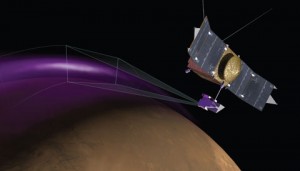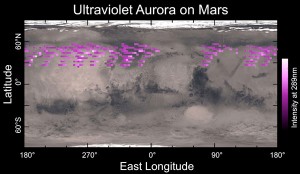NASA’s MAVEN spacecraft has detected dust high in Mars’s atmosphere and auroras across the planet’s northern hemisphere.
The bat-winged MAVEN spacecraft has now been in orbit for six months, dipping in and out of the Red Planet’s atmosphere in a looping orbit that slowly shifts around the planet. It’s investigating what goes on in Mars’s atmosphere and how the planet loses atmosphere over time.

University of Colorado
As part of that investigation, it’s now found two intriguing features high above the planet’s surface: dust and auroras.
MAVEN found the dust indirectly, by what grains do to the spacecraft when they hit it, explains mission principal investigator Bruce Jakosky (University of Colorado Boulder). When a speedy dust mote hits hard enough to vaporize and ionize its bits, the aftermath affects the spacecraft’s electrical potential and creates a milliseconds-long signature that the Langmuir Probe and Waves (LPW) instrument can detect.
The spacecraft has now completed more than 800 orbits around Mars, and the team has detected these dust impacts ever since turning on the instrument. But they don’t see the dust everywhere: MAVEN’s orbit precesses around Mars, meaning that over time the spacecraft’s closest point to the surface moves around the planet. LPW detected dust near local dawn and dusk, but not at night. “That’s an important clue, but we haven’t yet figured out how to interpret it,” Jakosky says.
The dust also seems unconnected to the surface features below. That’s unsurprising, Jakosky says, given that the dust is generally concentrated between 150 and 500 kilometers (90 and 300 miles) above the surface — it also occasionally shows up as high as 1,000 km — and it’s hard to imagine how something on the surface could affect things that high up.
The detection is curious, coming after a recent study reporting a transitory, dusty plume on Mars’s dawn limb. Image analysis by that team also suggested an altitude of a couple hundred kilometers, although others think the plume is likely much lower. But Jakosky cautions that we simply don’t know enough about either detection to know whether there’s a connection. The limb plume also only lasted for about a month, whereas MAVEN has detected its dust for six months.
It’s hard to explain how dust would get to this part of the atmosphere, Jakosky says. Raising it up from far below doesn’t make sense, physics-wise. Off-planet alternatives include dust from Mars’s two moons, Phobos and Deimos, or dust carried by the solar wind. It might also be comet debris the planet picks up along its orbit, although it doesn’t seem to be related to Comet Siding Spring, which brushed past Mars in October. But none of these alternatives is a shoo-in.
MAVEN’s orbit is just now sweeping around to the planet’s dayside. If LPW detects dust during local day, too, that will help scientists narrow in on where the dust is coming from.
Lights in the Sky
On Earth, auroras happen when the solar wind pours charged particles down the magnetic-field funnels at our planet’s poles and into the atmosphere. But Mars doesn’t have a global magnetic field; instead, it has remanent fields, ghost fields locked into the surface when molten, magnetizable rocks solidified during the brief era that the planet did have a global field, more than 4 billion years ago. These remanent fields show up mostly in the Martian southern hemisphere, where the surface rocks are older.

University of Colorado
The European Mars Express orbiter detected aurora in the southern hemisphere in 2005, where these magnetic anomalies exist. MAVEN has now seen aurora across much of the northern hemisphere, too.
The aurora persisted for five days, in a broad swath shown in the image at right. MAVEN didn’t observe the whole hemisphere simultaneously — only a region about the size of Africa — so the team doesn’t know for sure that the aurora covered the whole northern nightside, says team member Arnaud Stiepen (University of Colorado Boulder). But Stiepen thinks it’s likely the aurora covered that region entirely.
The aurora might have spread so far because there are essentially no magnetic fields in the northern hemisphere: with nothing to channel the energetic particles, they just dump into the atmosphere. Though this is a likely scenario, scientists need future observations to confirm it, says Nick Schneider (University of Colorado Boulder), who leads the team for the Imaging Ultraviolet Spectrometer instrument, which detected the auroral glow.
The electrons that created the northern aurora dove deep into Mars’s atmosphere, 50 to 100 km above the surface. That’s deeper than those in the southern hemisphere, which made it to 120 km or so. The northern electrons penetrated so much deeper because of their high energies: tens of thousands of electron volts, ten times higher than the ones that triggered the southern aurora. They seem to have come from a solar temper tantrum.
Auroras on Earth also typically happen around 100 km up, but Stiepen says that’s likely a coincidence: Mars and Earth are totally different environments, with atmospheres that “have close to nothing in common” and completely different magnetic setups.
 0
0









Comments
You must be logged in to post a comment.